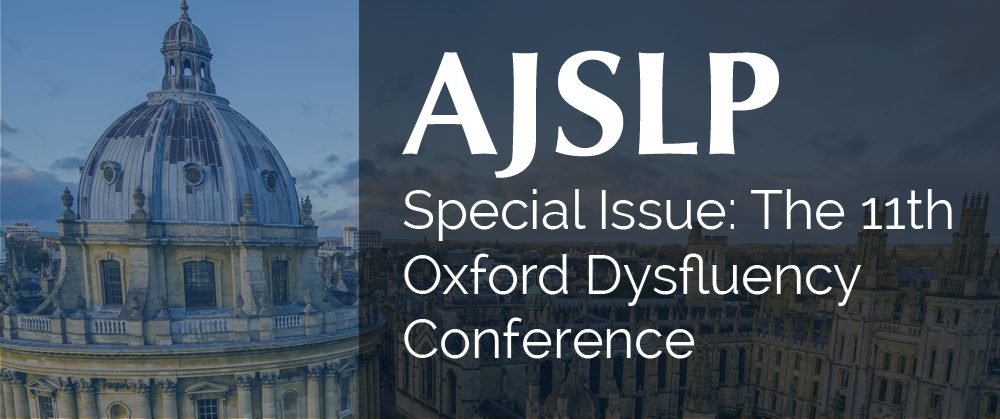Bridging the gap between research and practice in the field of fluency has always been the primary aim of the Oxford Dysfluency Conference. Every 3 years, experts in fluency disorders from around the world gather to present and discuss research that informs management and interventions supported by sound theory. For the 11th conference in 2017, researchers and clinicians met to explore the theme of “Challenge and Change.”
Of the 180 presentations at the conference, Conference Chairs and Special Issue Editors Sharon K. Millard and Shelley B. Brundage have selected 14 papers to share in a special issue of the American Journal of Speech-Language Pathology (AJSLP). These papers consist of both clinical and research articles, both of which contain a common thread of evidence-based practice.
Although the special issue will appeal to those who work with patients who stutter, the articles are also relevant beyond the field of dysfluency. Topics covered include the role of attention in therapy, developing resilience in children with chronic communication difficulties, and involving parents. This special issue also contains two articles by Katarzyna Węsierska, the 2017 winner of the Dave Rowley Award for International Collaborations. These articles focus on behavior and attitudes related to stuttering in her native Poland. These articles add an important international scope to the special issue.
An important theme shared by all of these articles is that a client’s voice is crucial in both treatment planning and goal-setting. Editors Millard and Brundage explain, “As clinicians, we need to understand the lived experience of having a communication disorder and how that experience evolves and impacts life over time (Nang, Hersh, Milton, & Lau, 2018; O’Dwyer, Walsh, & Leahy, 2018; Tichenor & Yaruss, 2018; Węsierska et al., 2018), people’s hopes and expectations from therapy (Cooke & Millard, 2018), and their experience of therapy and the process of change (Douglass, Schwab, & Alvarado. 2018; Everard & Howell, 2018), so that we may develop appropriate intervention packages” (Millard & Brundage, 2018).
We hope you explore the special issue, or delve into an article that interests you from the list below.
Listen to a Discussion With Dr. Sharon Millard About the Special Issue
Music: Chords For David by Pitx (c) copyright 2011 Licensed under a Creative Commons Attribution (3.0) license. http://dig.ccmixter.org/files/Pitx/30638 Ft: jlbrock
Explore the Special Issue
Brundage, S. B., & Rowe, H. (2018). Rates of typical disfluency in the conversational speech of 30-month-old Spanish–English simultaneous bilinguals. American Journal of Speech-Language Pathology, 27(3S), 1287–1298.
https://doi.org/10.1044/2018_AJSLP-ODC11-17-0200
Caughter, S., & Crofts, V. (2018). Nurturing a resilient mindset in school-aged children who stutter. American Journal of Speech-Language Pathology, 27(3S), 1111–1123.
https://doi.org/10.1044/2018_AJSLP-ODC11-17-0189
Cooke, K., & Millard, S. K. (2018). The most important therapy outcomes for school-aged children who stutter: An exploratory study. American Journal of Speech-Language Pathology, 27(3S), 1152–1163.
https://doi.org/10.1044/2018_AJSLP-ODC11-17-0195
Douglass, J. E., Schwab, M., & Alvarado, J. (2018). Covert stuttering: Investigation of the paradigm shift from covertly stuttering to overtly stuttering. American Journal of Speech-Language Pathology, 27(3S), 1235–1243.
https://doi.org/10.1044/2018_AJSLP-ODC11-17-0190
Everard, R. A., & Howell, P. (2018). We have a voice: Exploring participants’ experiences of stuttering modification therapy. American Journal of Speech-Language Pathology, 27(3S), 1273–1286.
https://doi.org/10.1044/2018_AJSLP-ODC11-17-0198
Harley, J. (2018). The role of attention in therapy for children and adolescents who stutter: Cognitive behavioral therapy and mindfulness-based interventions. American Journal of Speech-Language Pathology, 27(3S), 1139–1151.
https://doi.org/10.1044/2018_AJSLP-ODC11-17-0196
Millard, S. K., & Brundage, S. B. (2018). Introduction to the special issue: The 11th Oxford Dysfluency Conference. American Journal of Speech-Language Pathology, 27(3S), 1109–1110.
https://doi.org/10.1044/2018_AJSLP-ODC11-18-0239
Millard, S. K., Zebrowski, P., & Kelman, E. (2018). Palin Parent–Child Interaction therapy: The bigger picture. American Journal of Speech-Language Pathology, 27(3S), 1211–1223.
https://doi.org/10.1044/2018_AJSLP-ODC11-17-0199
Nang, C., Hersh, D., Milton, K., & Lau, S. R. (2018). The impact of stuttering on development of self-identity, relationships, and quality of life in women who stutter. American Journal of Speech-Language Pathology, 27(3S), 1244–1258.
https://doi.org/10.1044/2018_AJSLP-ODC11-17-0201
O’Dwyer, M., Walsh, I. P., & Leahy, M. M. (2018). The role of narratives in the development of stuttering as a problem. American Journal of Speech-Language Pathology, 27(3S), 1164–1179.
https://doi.org/10.1044/2018_AJSLP-ODC11-17-0207
St. Louis, K. O., Węsierska, K., & Polewczyk, I. (2018). Improving Polish stuttering attitudes: An experimental study of teachers and university students. American Journal of Speech-Language Pathology, 27(3S), 1195–1210.
https://doi.org/10.1044/2018_AJSLP-ODC11-17-0179
Tichenor, S., & Yaruss, J. S. (2018). A phenomenological analysis of the experience of stuttering. American Journal of Speech-Language Pathology, 27(3S), 1180–1194.
https://doi.org/10.1044/2018_AJSLP-ODC11-17-0192
Van Eerdenbrugh, S., Packman, A., O’Brian, S., & Onslow, M. (2018). Challenges and strategies for speech-language pathologists using the Lidcombe program for early stuttering. American Journal of Speech-Language Pathology, 27(3S), 1259–1272.
https://doi.org/10.1044/2018_AJSLP-ODC11-17-0185
Węsierska, K., Vanryckeghem, M., Krawczyk, A., Danielowska, M., Faściszewska, M., & Tuchowska, J. (2018). Behavior Assessment Battery: Normative and psychometric investigation among Polish adults who do and do not stutter. American Journal of Speech-Language Pathology, 27(3S), 1224–1234.
https://doi.org/10.1044/2018_AJSLP-ODC11-17-0187







